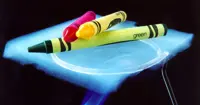Multi-component .nano-structures with tunable optical properties
12 Oct 2010
Scientists at the US Department of Energy's (DOE) Brookhaven National Laboratory report the first successful assembly of 3-D multi-component nanoscale structures with tunable optical properties that incorporate light-absorbing and -emitting particles.
 This work, using synthetic DNA as a programmable component to link the nanoparticles, demonstrates the versatility of DNA-based nanotechnology for the fabrication of functional classes of materials, particularly optical ones, with possible applications in solar-energy conversion devices, sensors, and nanoscale circuits. The research was published online September 29, 2010, in the journal NanoLetters.
This work, using synthetic DNA as a programmable component to link the nanoparticles, demonstrates the versatility of DNA-based nanotechnology for the fabrication of functional classes of materials, particularly optical ones, with possible applications in solar-energy conversion devices, sensors, and nanoscale circuits. The research was published online September 29, 2010, in the journal NanoLetters.
 BNL scientists used DNA linkers with three binding sites (black ''strings'') to connect gold nanoparticles (orange and red spheres) and fluorescent dye molecules (blue spheres) tagged with complementary DNA sequences. These units are self-assembled to form a body-center cubic lattice with nanoparticles at the corners and in the center, and fluorescent dye molecules in between.
BNL scientists used DNA linkers with three binding sites (black ''strings'') to connect gold nanoparticles (orange and red spheres) and fluorescent dye molecules (blue spheres) tagged with complementary DNA sequences. These units are self-assembled to form a body-center cubic lattice with nanoparticles at the corners and in the center, and fluorescent dye molecules in between.
''For the first time we have demonstrated a strategy for the assembly of 3-D, well-defined, optically active structures using DNA encoded components of different types,'' said lead author Oleg Gang of Brookhaven's Center for Functional Nanomaterials (CFN).
 Like earlier work by Gang and his colleagues, this technique makes use of the high specificity of binding between complementary strands of DNA to link particles together in a precise way.
Like earlier work by Gang and his colleagues, this technique makes use of the high specificity of binding between complementary strands of DNA to link particles together in a precise way.
In the current study, the DNA linker molecules had three binding sites. The two ends of the strands were designed to bind to complementary strands on ''plasmonic'' gold nanoparticles - particles in which a particular wavelength of light induces a collective oscillation of the conductive electrons, leading to strong absorption of light at that wavelength.






















